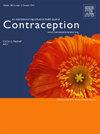ABORTION ACCESS IN A POST-DOBBS SOUTHEAST USA: TRAVEL PATTERNS AND RACIAL DISPARITIES
IF 2.3
2区 医学
Q1 OBSTETRICS & GYNECOLOGY
引用次数: 0
Abstract
Objectives
We assessed the impact of state-level abortion bans on abortion access in the Southeast US following Dobbs v Jackson Women’s Health Organization. Until North Carolina’s 12-week ban was implemented on July 1, 2023, it was one of the only southern states that provided second-trimester abortion care; border states had more restrictive laws. We used statewide North Carolina Division of Public Health data to examine changes in abortion utilization by race during 2017-2023.
Methods
We used interrupted time series coupled with machine learning and geographic analyses on abortion case data, focusing on out-of-state residents traveling to North Carolina. We compared observed abortion numbers to estimated counterfactual trends and explored variations based on gestational duration and race/ethnicity.
Results
Of 53,041 total abortions in North Carolina among out-of-state residents, 46.9% occurred post-Dobbs. Based on pre-Dobbs rates, there were an estimated 11,676 more abortions than expected in the first year post-Dobbs and 3,834 more than expected after the 12-week ban. We observed 9,749 (95% empirical CI: 9,643-9,845) additional first-trimester abortions and 1,792 (95% eCI: 1,748-1,837) additional second-trimester abortions during the first year after Dobbs. Post-12-week ban, first-trimester abortions remained significantly elevated, but second-trimester cases were rare. Compared with non-Hispanic White out-of-state individuals, non-Hispanic Black out-of-state individuals had significantly higher additional abortion rates, while Hispanic individuals had significantly lower rates.
Conclusions
State-level abortion bans shifted abortion travel patterns. North Carolina has become a crucial access point for abortion care in the Southeast. These findings highlight an unmet need for access to abortion care that disproportionately affects Black and Hispanic individuals, emphasizing how abortion bans exacerbate racial disparities in care.
后多布斯时期美国东南部的堕胎:旅行模式和种族差异
目的:在多布斯诉杰克逊妇女健康组织案之后,我们评估了美国东南部州一级的堕胎禁令对堕胎途径的影响。在北卡罗来纳州于2023年7月1日实施为期12周的禁令之前,它是南方仅有的几个提供中期堕胎护理的州之一;边境州有更严格的法律。我们使用全州北卡罗来纳州公共卫生部门的数据来检查2017-2023年期间种族堕胎使用率的变化。方法采用中断时间序列,结合机器学习和地理分析对堕胎病例数据进行分析,重点关注前往北卡罗来纳州的外州居民。我们将观察到的堕胎数字与估计的反事实趋势进行了比较,并探讨了基于妊娠期和种族/民族的变化。结果在北卡罗莱纳州53041例州外居民堕胎中,46.9%发生在多布斯手术后。根据多布斯法案实施前的数据,在多布斯法案实施后的第一年,堕胎人数比预期的多11676人,而在12周禁令实施后,堕胎人数比预期的多3834人。我们观察到,在多布斯术后的第一年,有9749例(95%经验CI: 9643 - 9845)额外的妊娠早期流产和1792例(95% eCI: 1748 - 1837)额外的妊娠中期流产。禁止妊娠12周后,妊娠早期流产率仍显著上升,但妊娠中期流产率很少。与非西班牙裔白人外州个体相比,非西班牙裔黑人外州个体的额外堕胎率明显更高,而西班牙裔个体的额外堕胎率明显更低。结论国家级堕胎禁令改变了堕胎旅行模式。北卡罗来纳州已经成为东南部堕胎护理的重要入口。这些发现突出了对获得堕胎护理的需求未得到满足,这对黑人和西班牙裔人群的影响尤为严重,强调了堕胎禁令如何加剧了护理方面的种族差异。
本文章由计算机程序翻译,如有差异,请以英文原文为准。
求助全文
约1分钟内获得全文
求助全文
来源期刊

Contraception
医学-妇产科学
CiteScore
4.70
自引率
17.20%
发文量
211
审稿时长
69 days
期刊介绍:
Contraception has an open access mirror journal Contraception: X, sharing the same aims and scope, editorial team, submission system and rigorous peer review.
The journal Contraception wishes to advance reproductive health through the rapid publication of the best and most interesting new scholarship regarding contraception and related fields such as abortion. The journal welcomes manuscripts from investigators working in the laboratory, clinical and social sciences, as well as public health and health professions education.
 求助内容:
求助内容: 应助结果提醒方式:
应助结果提醒方式:


